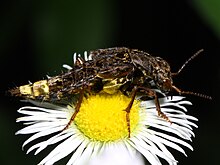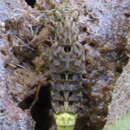Conservation Status
University of Alberta Museums tarafından sağlandı
Abundant.
- lisans
- cc-by-nc
- telif hakkı
- University of Alberta Museums
Cyclicity
University of Alberta Museums tarafından sağlandı
More abundant in early spring but active throughout summer and fall.
- lisans
- cc-by-nc
- telif hakkı
- University of Alberta Museums
Distribution
University of Alberta Museums tarafından sağlandı
Widespread and common in eastern and northwestern North America.
- lisans
- cc-by-nc
- telif hakkı
- University of Alberta Museums
General Description
University of Alberta Museums tarafından sağlandı
The head and thorax of the O. cingulatus larvae are dark brown-red and the abdomen is dirty-brown color (Voris, 1939). The mature larvae can reach 25mm long and 4mm wide. The adult size range is between 13-18 mm but can reach up to 21mm. The brown body of O.cingulatus is irregularly marked with spots of heavy dark pubescence (Downie and Arnett, 1996). The tip of the abdomen is densely covered with golden-yellowish pubescence which also covers the metasternum (Downie and Arnett, 1996). Like for the other species of the genus Ontholestes, the anterior angles of the prontum are extended and angular, quite pointed (Smetana and Davies, 2000). Most of the leg is reddish-brown with the femora darker and the apex and the lateral edge usually lighter but variable (Smetana and Davies, 2000). The tarsal formula is 5-5-5. The dark red antennae have 11 segments with the last obliquely notched.
- lisans
- cc-by-nc
- telif hakkı
- University of Alberta Museums
Habitat
University of Alberta Museums tarafından sağlandı
Woodland area but also open field. Adults and larvae are found on carrion, dung and decaying organic material (Arnett and Thomas, 2000).
- lisans
- cc-by-nc
- telif hakkı
- University of Alberta Museums
Life Cycle
University of Alberta Museums tarafından sağlandı
Two or three days before pupation, the larva forms a nest-like cavity in a substrate like dung or soil, encloses itself in it and pupates (Voris, 1939). The pupal period varies between 10 to 14 days (Voris, 1939). Males of the species O. cingulatus were shown to exhibit an adaptive mate-guarding behavior. The male O. cingulatus stays close to the female after copulation while she oviposits to avoid fertilization from other males (Alcock, 1991). If threatened, O.cingulatus will bring the tip of its abdomen in contact with the threat and release a chemical defense.
- lisans
- cc-by-nc
- telif hakkı
- University of Alberta Museums
Trophic Strategy
University of Alberta Museums tarafından sağlandı
A predator of flies associated with dung and carrion but also attracted to other decaying organic matter such as fungi, fruits and vegetables.
- lisans
- cc-by-nc
- telif hakkı
- University of Alberta Museums
Ontholestes cingulatus
(
Almanca
)
wikipedia DE tarafından sağlandı
Ontholestes cingulatus ist ein nordamerikanischer Käfer aus der Familie der Kurzflügler (Staphylinidae).
Merkmale
Die Käfer erreichen eine Körperlänge von 13 bis maximal 21 Millimetern. Ihr Kopf, der Halsschild und die Deckflügel sind dunkelbraun gefärbt und mit helleren Härchen dicht behaart, Haarbüschel aus schwarzen Haaren formen schwarze Flecken auf allen Körperregionen. Das Abdominalende ist durch glänzend-goldene Härchen bedeckt, die auch einen Gürtel unterhalb des Thorax zwischen dem zweiten und dritten Beinpaar bilden. Die Beine sind weitestgehend rotbraun mit dunklem Oberschenkel (Femur), die Tarsenformel ist 5-5-5, alle drei Beine besitzen also jeweils 5 Fußglieder. Die Facettenaugen sind groß und hervorstehend. Die Antenne besteht aus 11 Antennengliedern, wobei die letzten gebogen und verdickt sind.
Die Larven erreichen eine maximale Länge von 25 Millimeter und eine Breite von etwa 4 Millimeter.
Vorkommen und Lebensweise
Die Käfer sind über weite Teile des östlichen und nordwestlichen Nordamerikas in den Vereinigten Staaten und Kanada verbreitet. Sie kommen in der Nähe von Holz, an Pilzen und zudem im Bereich von Aas bzw. Kadavern vor. Die adulten Käfer ernähren sich von Fliegenmaden, Milben, Käferlarven und anderen Kleintieren, die Larven von Aas und Pilzen.
Die Männchen der Käfer bewachen die von ihnen begatteten Weibchen während der Eiablage, um Kopulationen mit anderen Männchen zu verhindern. Die Eier werden auf Aas und Pilzen oder in deren Nähe abgelegt. Sie verpuppen sich in kleinen Kammern im Boden oder Dung, die sie wenige Tage vorher gegraben haben. Die Puppenruhe dauert 10 bis 14 Tage.
Die Adulten sind vom Frühjahr bis zum Herbst aktiv. Die Käfer können ihre Flügel innerhalb von Sekundenbruchteilen ausfalten und abfliegen. Beim Laufen halten sie ihr auffälliges Hinterteil erhoben, bei Gefahr berühren sie Angreifer mit dem Abdomen und entlassen ein Wehrsekret.
Literatur
- Lorus Milne, Margery Milne: Field Guide to Insects and Spiders. National Audubon Society, Chantacleer Press, 1980; S. 547–548. ISBN 0-394-50763-0.
Weblinks
– Sammlung von Bildern, Videos und Audiodateien

- lisans
- cc-by-sa-3.0
- telif hakkı
- Autoren und Herausgeber von Wikipedia
Ontholestes cingulatus: Brief Summary
(
Almanca
)
wikipedia DE tarafından sağlandı
![src=]()
Ontholestes cingulatus
Ontholestes cingulatus ist ein nordamerikanischer Käfer aus der Familie der Kurzflügler (Staphylinidae).
- lisans
- cc-by-sa-3.0
- telif hakkı
- Autoren und Herausgeber von Wikipedia
Ontholestes cingulatus
(
İngilizce
)
wikipedia EN tarafından sağlandı
Ontholestes cingulatus, known generally as the gold-and-brown rove beetle or carrion beetle, is a species of large rove beetle in the family Staphylinidae.[1][2][3]

Gold-and-brown rove beetle,
Ontholestes cingulatus
References
- lisans
- cc-by-sa-3.0
- telif hakkı
- Wikipedia authors and editors
Ontholestes cingulatus: Brief Summary
(
İngilizce
)
wikipedia EN tarafından sağlandı
Ontholestes cingulatus, known generally as the gold-and-brown rove beetle or carrion beetle, is a species of large rove beetle in the family Staphylinidae.

Gold-and-brown rove beetle, Ontholestes cingulatus
- lisans
- cc-by-sa-3.0
- telif hakkı
- Wikipedia authors and editors


 Gold-and-brown rove beetle, Ontholestes cingulatus
Gold-and-brown rove beetle, Ontholestes cingulatus